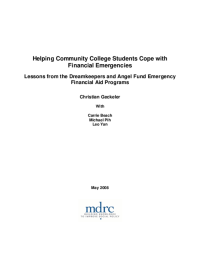Helping Community College Students Cope with Financial Emergencies
Lessons from the Dreamkeepers and Angel Fund Emergency Financial Aid Programs
Lumina Foundation for Education created the Dreamkeepers and Angel Fund Emergency Financial Aid Programs to assist community college students who are at risk of dropping out because of unexpected financial crises. Both programs are multiyear pilot projects that began in 2005 and are administered by Scholarship America and the American Indian College Fund, respectively. Eleven community colleges are participating in Dreamkeepers; 26 Tribal Colleges and Universities (TCUs) are participating in Angel Fund. Each Dreamkeepers college receives up to $100,000 over three years; each TCU receives nearly $26,000 over five years. The colleges are responsible for designing the programs and raising funds, both to sustain their programs and to continue receiving matching funds from the initiative.
Lumina asked MDRC to evaluate these programs during their first two years of program design and implementation. The key findings are as follows:
- In their first two years, the Dreamkeepers and Angel Fund programs awarded over $845,000 in emergency financial aid to more than 2,400 students. Students at the Dreamkeepers colleges most frequently asked for help with housing expenses, followed by transportation and books. Students at the TCUs most often needed funds for transportation, and also frequently requested help with child care, housing, and utilities.
- The Dreamkeepers and Angel Fund programs set general parameters but gave the colleges the freedom to customize their programs. As such, their designs vary considerably. Most colleges award grants; a few offer loans. Some colleges require detailed applications, reviewed by senior administrators or a small committee; others empower one individual or frontline staff to make aid decisions.
- Dreamkeepers aid recipients are more likely than other students at their colleges to be older students, parents, first-year students, enrolled full time, enrolled in vocational study, and recipients of financial aid. They are also more likely to take and complete more credits. At some Dreamkeepers colleges, women and African-American students are more likely than other demographic groups to receive emergency assistance.
- Both student aid recipients and administrators say that the emergency aid helped students remain in college, and data show that aid recipients reenroll at rates roughly comparable to the average on their campuses. Aid recipients may also benefit by becoming better connected to on- and off-campus supportive services.
- Nearly all the colleges met or exceeded their fundraising goals during their first two years. The Angel Fund colleges, however, tend to have limited fundraising capacities and remain concerned about meeting their fundraising requirement over the remaining years of the program.
- For colleges interested in starting similar programs, this report suggests several key challenges to address: defining what constitutes a financial emergency, building a flexible administrative structure that safeguards funds yet quickly responds to student needs, ensuring that all eligible students are aware of the program and have equal opportunities to access funds, finding sources of funding, working with technical assistance providers, and using data to evaluate programs.






